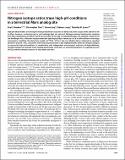Nitrogen isotope ratios trace high-pH conditions in a terrestrial Mars analog site
Date
26/02/2020Metadata
Show full item recordAbstract
High-pH alkaline lakes are among the most productive ecosystems on Earth and prime targets in the search for life on Mars; however, a robust proxy for such settings does not yet exist. Nitrogen isotope fractionation resulting from NH3 volatilization at high pH has the potential to fill this gap. To validate this idea, we analyzed samples from the Nördlinger Ries, a Miocene impact crater lake that displayed pH values up to 9.8 as inferred from mineralogy and aqueous modeling. Our data show a peak in δ15N of +17‰ in the most alkaline facies, followed by a gradual decline to around +5‰, concurrent with the proposed decline in pH, highlighting the utility of nitrogen isotopes as a proxy for high-pH conditions. In combination with independent mineralogical indicators for high alkalinity, nitrogen isotopes can provide much-needed quantitative constraints on ancient atmospheric Pco2 (partial pressure of CO2) and thus climatic controls on early Earth and Mars.
Citation
Stüeken , E E , Tino , C , Arp , G , Jung , D & Lyons , T W 2020 , ' Nitrogen isotope ratios trace high-pH conditions in a terrestrial Mars analog site ' , Science Advances , vol. 6 , no. 9 , eaay3440 . https://doi.org/10.1126/sciadv.aay3440
Publication
Science Advances
Status
Peer reviewed
ISSN
2375-2548Type
Journal article
Description
This research was financially supported by the Leverhulme Trust to T.W.L. E.E.S. acknowledges start-up funds from the University of St. Andrews. The NASA Astrobiology Institute under Cooperative Agreement no. NNA15BB03A issued through the Science Mission Directorate also provided funds as did a NASA Fellowship in support of C.T. under Cooperative Agreement no. 80NSSC19K1739 issued through the NASA Office of STEM Engagement.Collections
Items in the St Andrews Research Repository are protected by copyright, with all rights reserved, unless otherwise indicated.

